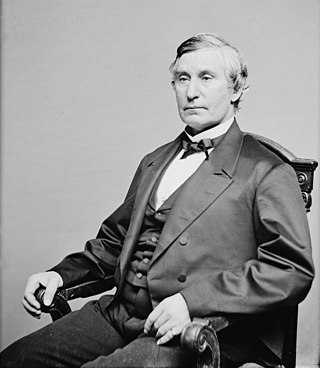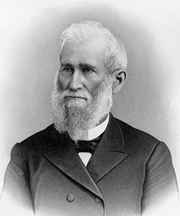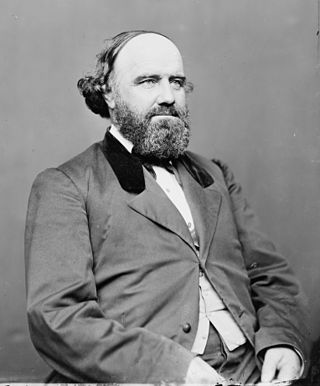
The Central Pacific Railroad (CPRR) was a rail company chartered by U.S. Congress in 1862 to build a railroad eastwards from Sacramento, California, to complete most of the western part of the "First transcontinental railroad" in North America. Incorporated in 1861, CPRR ceased independent operations in 1875 when the railroad was leased to the Southern Pacific Railroad. Its assets were formally merged into Southern Pacific in 1959.

America's first transcontinental railroad was a 1,911-mile (3,075 km) continuous railroad line built between 1863 and 1869 that connected the existing eastern U.S. rail network at Council Bluffs, Iowa, with the Pacific coast at the Oakland Long Wharf on San Francisco Bay. The rail line was built by three private companies over public lands provided by extensive U.S. land grants. Building was financed by both state and U.S. government subsidy bonds as well as by company-issued mortgage bonds. The Western Pacific Railroad Company built 132 miles (212 km) of track from the road's western terminus at Alameda/Oakland to Sacramento, California. The Central Pacific Railroad Company of California (CPRR) constructed 690 miles (1,110 km) east from Sacramento to Promontory Summit, Utah Territory. The Union Pacific Railroad (UPRR) built 1,085 miles (1,746 km) from the road's eastern terminus at the Missouri River settlements of Council Bluffs and Omaha, Nebraska, westward to Promontory Summit.

A transcontinental railroad or transcontinental railway is contiguous railroad trackage, that crosses a continental land mass and has terminals at different oceans or continental borders. Such networks can be via the tracks of either a single railroad or over those owned or controlled by multiple railway companies along a continuous route. Although Europe is crisscrossed by railways, the railroads within Europe are usually not considered transcontinental, with the possible exception of the historic Orient Express. Transcontinental railroads helped open up interior regions of continents not previously colonized to exploration and settlement that would not otherwise have been feasible. In many cases they also formed the backbones of cross-country passenger and freight transportation networks. Many of them continue to have an important role in freight transportation and some like the Trans-Siberian Railway even have passenger trains going from one end to the other.

Amasa Leland Stanford was an American attorney, industrialist, philanthropist, and Republican Party politician from California. He served as the 8th Governor of California from 1862 to 1863 and represented the state in the United States Senate from 1885 until his death in 1893. He and his wife Jane founded Stanford University, named after their late son.

This section of the timeline of United States history concerns events from 1860 to 1899.
The Pacific Railroad Acts of 1862 were a series of acts of Congress that promoted the construction of a "transcontinental railroad" in the United States through authorizing the issuance of government bonds and the grants of land to railroad companies. In 1853, the War Department under then Secretary of War Jefferson Davis was authorized by the Congress to conduct surveys of five different potential transcontinental routes from the Mississippi ranging from north to south. It submitted a massive twelve volume report to Congress with the results in early 1855. However, no route or bill could be agreed upon and passed authorizing the Government's financial support and land grants until the secession of the southern states in 1861 removed their opposition to a central route. The Pacific Railroad Act of 1862 was the original act. Some of its provisions were subsequently modified, expanded, or repealed by four additional amending Acts: The Pacific Railroad Act of 1863, Pacific Railroad Act of 1864, Pacific Railroad Act of 1865, and Pacific Railroad Act of 1866.

The Crédit Mobilier scandal was a two-part fraud conducted from 1864 to 1867 by the Union Pacific Railroad and the Crédit Mobilier of America construction company in the building of the eastern portion of the first transcontinental railroad from the Missouri River to Utah Territory. The story was broken by The New York Sun during the 1872 campaign of Ulysses S. Grant.

Oakes Ames was an American businessman, investor, and politician. He was a member of the United States House of Representatives from Massachusetts. As a congressman, he is credited by many historians as being the single most important influence in the building of the Union Pacific portion of the transcontinental railroad. He is also noted for the subsequent scandal that alleged the improper sale of stock of the railroad's construction company.

The Senate Committee on Rules and Administration, also called the Senate Rules and Administration Committee, is responsible for the rules of the United States Senate, administration of congressional buildings, and with credentials and qualifications of members of the Senate, including responsibility for contested elections. The committee is not as powerful as its House counterpart, the House Committee on Rules, as it does not set the terms of debate for individual legislative proposals, since the Senate has a tradition of open debate. Some members of the committee are also ex officio members of the Joint Committee on the Library and the Joint Committee on Printing.

Jacob Merritt Howard was an American attorney and politician. He was most notable for his service as a U.S. Representative and U.S. Senator from the state of Michigan, and his political career spanned the American Civil War.

Josiah Williams Begole was an American politician serving as a U.S. Representative from 1873 to 1875 and the 19th governor of Michigan from 1883 to 1885.
The Kansas Pacific Railway (KP) was a historic railroad company that operated in the western United States in the late 19th century. It was a federally chartered railroad, backed with government land grants. At a time when the first transcontinental railroad was being constructed by the Central Pacific and the Union Pacific, it tried and failed to join the transcontinental ranks. It was originally the "Union Pacific, Eastern Division", although it was completely independent. The Pennsylvania Railroad, working with Missouri financiers, designed it as a feeder line to the transcontinental system. The owners lobbied heavily in Washington for money to build a railroad from Kansas City to Colorado, and then to California. It failed to get funding to go west of Colorado. It operated many of the first long-distance lines in the state of Kansas in the 1870s, extending the national railway network westward across that state and into Colorado. Its main line furnished a principal transportation route that opened up settlement of the central Great Plains, and its link from Kansas City to Denver provided the last link in the coast-to-coast railway network in 1870. The railroad was consolidated with the Union Pacific in 1880, and its mainline continues to be an integral part of the Union Pacific network today.

The 38th United States Congress was a meeting of the legislative branch of the United States federal government, consisting of the United States Senate and the United States House of Representatives. It met in Washington, D.C., from March 4, 1863, to March 4, 1865, during the last two years of President Abraham Lincoln's first term in office. The apportionment of seats in the House of Representatives was based on the 1860 United States census. The Senate had a Republican majority, and the House of Representatives had a Republican plurality.

Samuel Clarke Pomeroy was a United States senator from Kansas in the mid-19th century. He served in the United States Senate during the American Civil War. Pomeroy also served in the Massachusetts House of Representatives. A Republican, he also was the mayor of Atchison, Kansas, from 1858 to 1859, the second president of the Atchison, Topeka and Santa Fe Railroad, and the first president to oversee any of the railroad's construction and operations. Pomeroy succeeded Cyrus K. Holliday as president of the railroad on January 13, 1864.

The 37th United States Congress was a meeting of the legislative branch of the United States federal government, consisting of the United States Senate and the United States House of Representatives. It met in Washington, D.C., from March 4, 1861, to March 4, 1863, during the first two years of Abraham Lincoln's presidency. The apportionment of seats in the House of Representatives was based on the 1850 United States census.

The 41st United States Congress was a meeting of the legislative branch of the United States federal government, consisting of the United States Senate and the United States House of Representatives. It met in Washington, D.C. from March 4, 1869, to March 4, 1871, during the first two years of Ulysses S. Grant's presidency. The apportionment of seats in the House of Representatives was based on the 1860 United States census. Both chambers had a Republican majority.

Thomas Clark Durant was an American physician, businessman, and financier. He was vice-president of the Union Pacific Railroad (UP) in 1869 when it met with the Central Pacific railroad at Promontory Summit in Utah Territory. He created the financial structure that led to the Crédit Mobilier scandal. He was interested in hotels in the Adirondacks and once owned the yacht Idler.

John Wesley Longyear was a United States representative from Michigan and a United States district judge of the United States District Court for the Eastern District of Michigan.
The Senate Committee on Railroads is a defunct committee of the United States Senate. It succeeded the Committee on the Pacific Railroad on March 12, 1873. The committee reviewed legislation and matters related to railroad transportation on the United States. The committee existed until April 8, 1921, when it was abolished due to inactivity. The committee's role waned after the 50th Congress (1887-89) as other Senate committees acquired legislative jurisdiction over railroad matters. The United States Senate Committee on Interstate Commerce, in particular, focused on regulating railroad rates and assuring safety of railroad passengers and crews. A separate Committee on Pacific Railroads also operated from 1893 to 1921, investigating the financial status of the Union Pacific Railroad.

Thousand Mile Tree is a pine tree located in Weber Canyon near the community of Henefer, Utah along the Overland Route of the Union Pacific Railroad. In January 1869, graders of the railroad found a similar tree standing next to the line they were constructing, which by coincidence marked the western progress of exactly one thousand miles of road from Omaha, Nebraska/Council Bluffs, Iowa, the eastern terminus of the First transcontinental railroad.